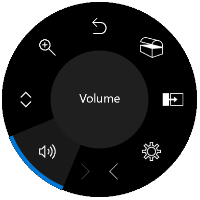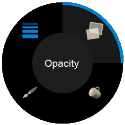Revu on the Microsoft Surface and Surface Studio
Revu behaves in much the same way on Microsoft Surface devices as it does on desktop PCs, though there are some features and behaviors that are specific to the Surface Dial. All Surface devices can take advantage of the Surface Dial menu and its special interactions with selected tabs. Surface devices that support using the Surface Dial directly on the screen, like the Surface Studio, also enjoy a few additional features.
 All Surface devices can take advantage of the Surface Dial menu, which places commonly used features in a menu accessible using the Surface Dial. Press the Surface Dial to call up this menu. If the Surface Dial is currently on the screen, the menu will encircle it, otherwise it will appear on the screen as a stand-alone wheel menu. It's comprised of standard Surface Dial menu items as well as Revu-specific menu items, including:
All Surface devices can take advantage of the Surface Dial menu, which places commonly used features in a menu accessible using the Surface Dial. Press the Surface Dial to call up this menu. If the Surface Dial is currently on the screen, the menu will encircle it, otherwise it will appear on the screen as a stand-alone wheel menu. It's comprised of standard Surface Dial menu items as well as Revu-specific menu items, including:
- Volume: Adjusts the volume of the device's speakers.
- Scroll: Scrolls the main workspace either up & down or left & right. Press the Surface Dial to switch the scroll direction.
- Zoom: Zooms the main workspace in and out.
- Undo: Undoes and redoes actions in the history. Continue scrolling left to undo actions in order or scroll to the right to redo undone actions.
- Tool Chest: Opens the Tool Chest panel. See Tool Chest Panel below for more information about how the Surface Dial interacts with it.
- Split-Zoom: Engages MultiView and splits the main workspace vertically. Rotate the Surface Dial to zoom the split view in and out while maintaining the view of the original document. See On-screen Features below for more detail regarding using Split-Zoom when the Surface Dial is on the screen.
-
Properties:
 Engages a limited menu of markup properties in a separate wheel. When a markup on the document is active, the properties for it can be changed. When no markup on the document is active, but a markup on the markups tab is, the default settings for that markup can be changed. Otherwise, the menu will be dimmed. The properties available include Line Width, Color, Fill, and Opacity (both Line and Fill, when applicable).
Engages a limited menu of markup properties in a separate wheel. When a markup on the document is active, the properties for it can be changed. When no markup on the document is active, but a markup on the markups tab is, the default settings for that markup can be changed. Otherwise, the menu will be dimmed. The properties available include Line Width, Color, Fill, and Opacity (both Line and Fill, when applicable). -
Panels: Opens the Panels menu. Selecting a panel will open it (if necessary) and make it active.
Only Surface devices that support on-screen Surface Dial interactions like the Surface Studio can take advantage of these features. Generally speaking, the location of the Surface Dial on the screen will determine its function.
- Press the Surface Dial to call up the Surface Dial menu, as described under Off-screen Features above.
- When the Surface Dial is in either the Tool Chest or Layers panel, it will automatically engage the functionality associated with that tab as described in the Off-screen section above. See The Tool Chest and Layers Panels below for more information.
- When the Surface Dial is on a drawing, rotating it will zoom in and out of the drawing.
- When the Surface Dial is on a markup, rotating it will select various markup properties as described in the Off-screen section above. See Properties above for more information.
- When in Split-Zoom mode, placing the Surface Dial on one of the split views will cause a loop to appear on the other view, representing the position of the Surface Dial on the other view. Rotating the Surface Dial will zoom the other view and sliding the Surface Dial around will move the view on the zoomed drawing.
The Tool Chest and Layers Panels
The Surface Dial can interact directly with both the Tool Chest and the Layers panels.
 Tool Chest Panel
Tool Chest Panel
When the Surface Dial engages the Tool Chest panel (either engaged in off-screen or on-screen mode), use it to move through tools and tool sets quickly and easily.
- Rotate the Surface Dial to scroll through tools.
- Press the Surface Dial to skip through tool sets.
 Layers Panel
Layers Panel
When Revu detects a Surface Dial, a Dial submenu appears in the Options menu on the Layers panel. This menu is present whether the Surface Dial is in on-screen or off-screen mode.
Dial: This menu only appears when Revu detects the presence of a Surface Dial. Select a mode for the Surface Dial that determines how layers are shown as the Surface Dial is rotated:
- Isolate: Shows only the current layer.
- Build: Shows each layer scrolled through in progressing order.
- Select: Scrolls through layers without changing the view. Press the Surface Dial to select the current layer, either hiding or showing it, depending on its current state.